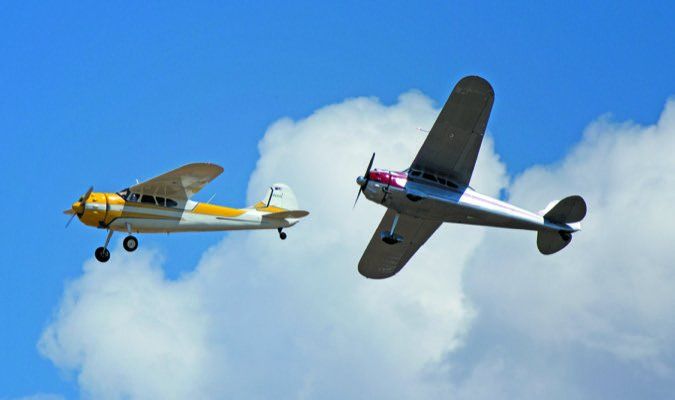The venerable Cessna 190 series was not the first business aircraft by a long shot, although it was a first for Cessna. These days, for owners wanting to own a piece of aviation history, it is probably the most practical of classics because it’s a decent people hauler. Even better, it’s not overly expensive to maintain, compared to other classics, that is. There’s no fabric, and parts are generally available unlike other classic machines including the Beech Staggerwing, Spartan Executive and Stinson Reliant.
For the skilled tailwheel pilot, a Cessna 190/195 isn’t tough to handle. Think of it as the link between the poorly harmonized, high adverse yaw radial-engine classics of the 1930s with the feet-on-the floor machines of today, carrying on only the adverse yaw.
Many vintage aircraft are indeed works of art, but the 195 is actually a practical classic. One owner refers to his 195 as “a Cessna 206 that gets preferred parking at the fly-in breakfasts.”
A direct descendant of the 1934 C-34 Airmaster, the C-190 series represents a lot of Cessna heritage-it was the first all-metal Cessna, and the last Cessna to be built with a radial engine.
Here’s a fresh look at the current 190/195 market and what to expect when shopping for one.
Now and Zen
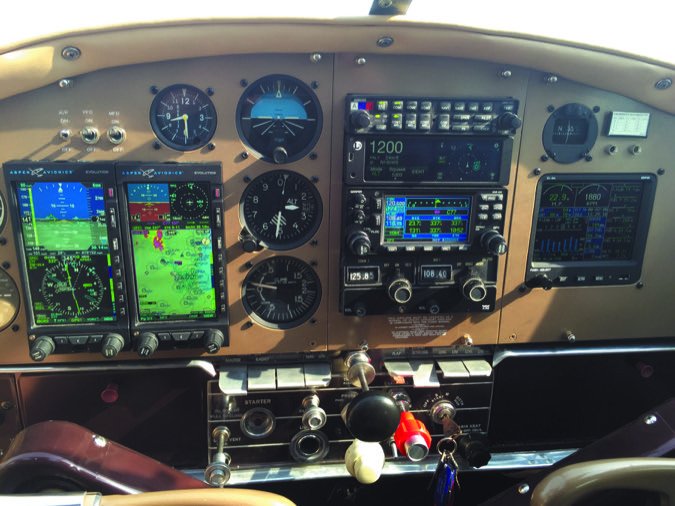
As expected, our latest market scan showed that restored and remanufactured models get top dollar, but they’re far from untouchable. We spotted a 4000-hour 1948 195 for sale in Indiana priced at $87,500 by a “proud owner,” as an example. Its radial engine has 1115 since a major overhaul, and the plane has new carpeting, mandate-compliant ADS-B and a claimed quality repair to exacting standards after an inevitable groundloop. Here’s some history of the model line to help sort out the buying decision.
The 195 came in as Beech quit building the Model 17 Staggerwing and took its place as a cabin-class bizplane, at a significantly lower cost. The Bonanza came out about the same time, but had such anemic power it couldn’t carry nearly the load and would run out of aft CG quite easily. The Cessna Citation of its day, the 190/195 wasn’t a huge seller, but there are plenty of examples flying. Cessna cranked out 1099 variants of the 190 series-190s, 195s and military LC-126s-from 1947 through 1954. Nearly 80 percent were 195s. The FAA registry lists nearly 700 registered 190-series aircraft, but nobody’s sure how many are actually airworthy. The main distinction among the models is the engine.
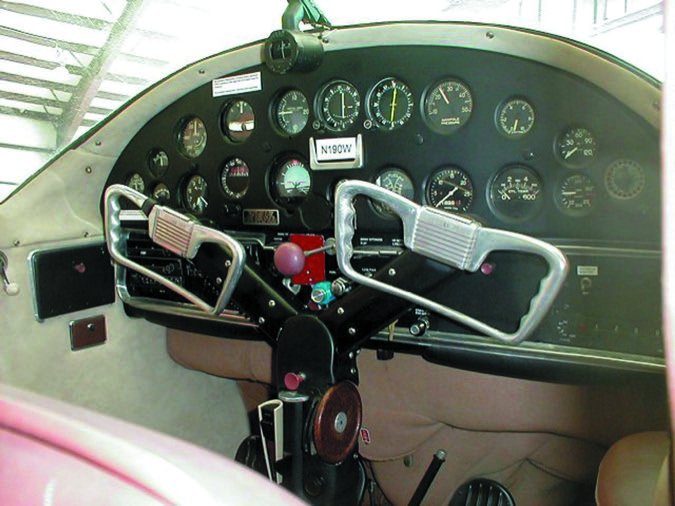
The 190 had a Continental W-670 radial pounding out 240 HP and was alleged to be Cessna president Dwane Wallace’s personal favorite. The others had Jacobs R-755 engines of either 300 HP, 275 HP or owner-furnished 245 HP. Most of the 195s were originally equipped with the 300-HP engines, but many have been retrofitted with 275s or 245s. There are still quite a few of the smoother-running Continental-powered airplanes flying, but about half have since been converted to 195s with the Jacobs engines, since the support for the Jake is better.
Owners report that the performance is comparable between the 190 and the “little” 245-HP 195, while the 275-HP and 300-HP 195s are, of course, peppier. The C-195B’s 275-HP R755-B2 engine is generally considered to be the most reliable of the group, even though all three of the Jacobs engines have the same displacement. The 300 got a deeper intake manifold to get its extra 25 horses, which seem to make it more susceptible to case cracking.
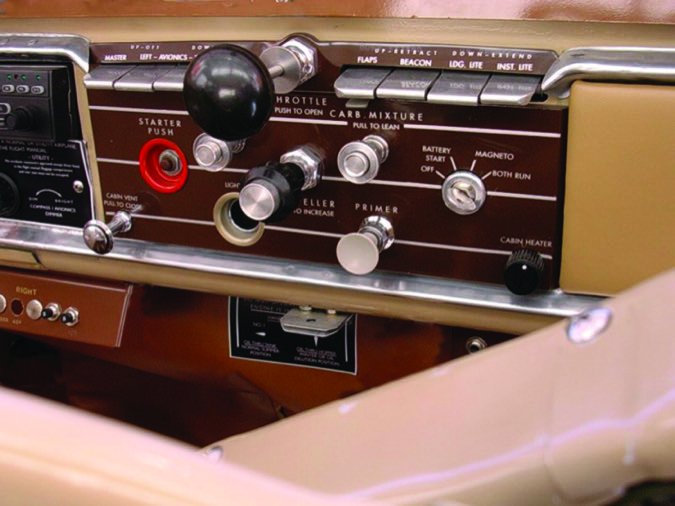
The other significant changes in the airframes over the years were slightly larger flaps along with a modified horizontal tail at serial number 16084. And in 1953, the Goodyear crosswind gear was offered as standard, along with a lighter, springier set of main gear struts. The crosswind gear casters so the airplane tracks down the centerline in a crab but the wheels remain parallel-more or less-to the runway centerline. It looks odd, but works we’ll on those few airplanes that have it.
Performance, Handling
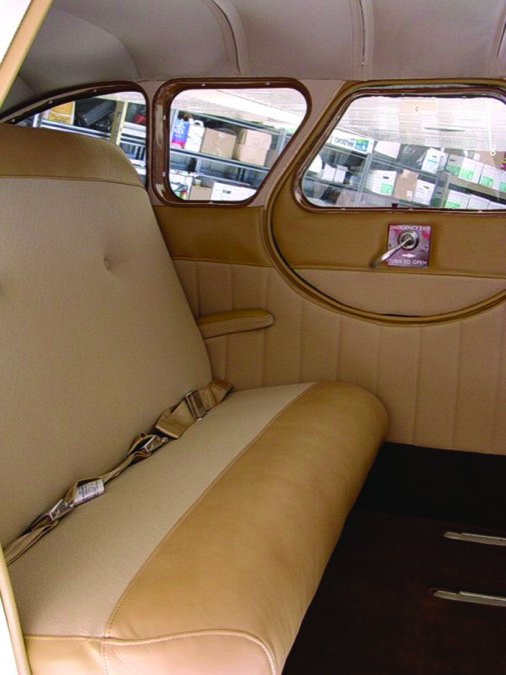
Above 8000 feet the airplane is an honest 140-knot machine, but down low it is thirsty and slow.
Expect 12.5-14 GPH for a normal cruise of 140 knots above 8000 feet; you can burn more, but it won’t go much faster. Fuel burn is something in the high 20s during takeoff.
With 76 gallons of usable fuel on board, you can usually plan on a range of 520 to 780 miles. With the 275-HP Jacobs, count on a cruise of a bit over 130 knots, burning about 13.5 to 14 GPH, at a comfortable and rumbling 1900 to 2000 RPM. Plan on oil consumption of between 0.5 pint to about 1 quart per hour-depending on engine condition. The ship holds five gallons of oil when it’s at full capacity.
A pilot has to be willing to put the effort into transitioning into the airplane. The ground handling requires some finesse and the sight picture is unusual. The pilot has to learn how to look straight ahead. Not only does it sit high -which makes for a lot of hard landings as newbies flare too low-the pilot’s seat is angled slightly right and the copilot’s seat is angled left. That means there is a tendency to look across the cowling on landing instead of straight ahead (like a C-46 Commando), which causes problems in the checkout. In addition, if the gear is not properly aligned, the airplane goes from being manageable to turning the pilot into a test pilot. Stalls are Cessna-like, which is to say gentlemanly.
Control harmony is superb, although the airplane has adverse aileron yaw, but pitch, roll and yaw control is beautifully harmonized, and responsive without being twitchy. It feels like a luxury car from the 1950s. Still, the airplane will not stay where you put it. Most have some degree of long-term phugoid, plus they will simply wander after a half-dozen seconds no matter how we’ll trimmed. It’s a fingertip correction, but you have to fly the airplane all the time. Any slop or worn bearings in the control and trim system makes the wandering worse. Nevertheless, it does not wallow in turbulence.
The visibility from the flight deck is really nothing to brag about, since the big engine blocks the view forward and especially to the pilot’s right. Turns during taxiing are a good idea. In flight, the wing’s leading edge is just about at the pilot’s eye level, forcing him to lean forward to see around it. As a minor compensation, the windshield’s top projects we’ll aft of the pilot’s head, as in a Cessna 177 Cardinal, so visibility into a turn is quite good.
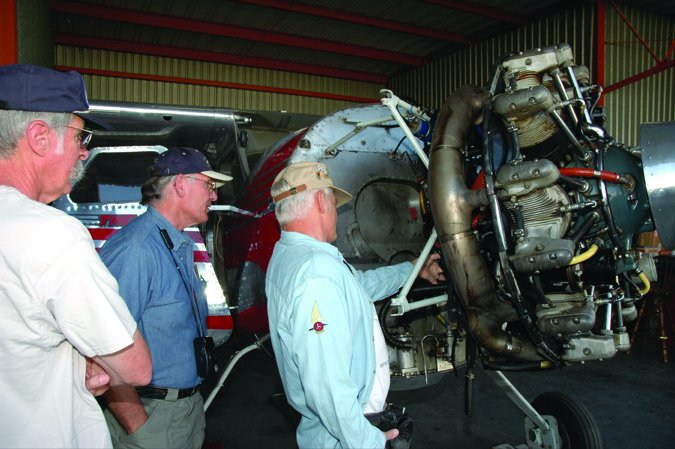
The original Goodyear brakes are satisfactory if-and it’s a big if-they are maintained. The Cleveland brake conversion comes from a Cessna 310, a heavier, nosewheel airplane, and are more brakes than the airplane needs. As a result, the pilot has to learn how to modulate them or it’s possible to flip the airplane.
A pilot should be able to both three-point and wheel-land the airplane. Neither is better. However, the power needs to be completely at idle prior to touchdown. One way pilots get into trouble is carrying power through touchdown and then closing the throttle and losing the airflow over the rudder. It three-points beautifully. Once down, the yoke must be pinned fully aft or the airplane will start bouncing. If it starts, full aft yoke stops it quickly. Remember that this is a relatively heavy taildragger with the CG we’ll behind the main gear. If it gets squirrelly on rollout, brakes may not handle it; power and air over the tail and perhaps a go-around are more likely to be successful. Allow a swerve of more than 10 or 15 degrees to develop and there isn’t enough brake to stop it. A groundloop in this airplane will usually cause major damage to the gearbox, fuselage and wings, perhaps even resulting in a total loss.
Potential buyers should have a mechanic familiar with the model check the airplane they have in mind for groundloop damage. If it’s been repaired correctly, no problem, but if not you could be in for expensive remedial work. On an important side note, a prebuy by someone who knows 195s is essential, and a lot of owners have taken serious financial hits by not doing so.
Two types of spring steel gear legs were installed. The later “light” type on the 1953 and 1954 models was thinner and weighed about 20 pounds less. The earlier gear is much stiffer. Aside from the weight savings, the more flexible light gear may be a little easier on the airframe, especially if a groundloop occurs. Among the 195 cognoscenti, debate rages on the use of the crosswind wheels. Some experienced pilots say that only fools fly without them.
Others maintain that with a little care and experience, a pilot will have no problems with the “straight” gear. The Goodyear castering gear was installed as standard equipment in 1953, but due to poor parts availability, not many of today’s aircraft have them. The extra clearance demanded by the swiveling wheels precludes installation of wheel fairings.
Later models have larger air brakes (some people call them flaps) with a lower deployment speed. It was not an improvement as the airplane is so clean that it’s hard to slow down to the white arc.
Payload, Comfort, Range
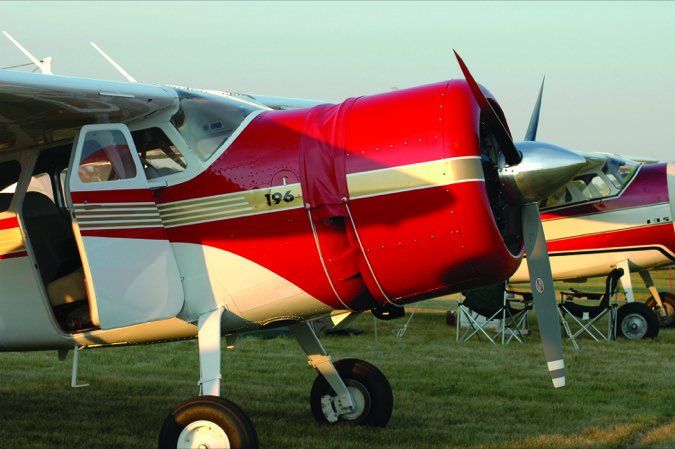
Remember, this is a cabin-class airplane, so there’s room to move around in flight. Gross weight of the series is 3350 pounds. A nicely equipped 195 with full IFR avionics and an autopilot will weigh in at 2100 to 2200 pounds, allowing a payload of over a half ton. Roominess is the aircraft’s strong suit, with space for four comfortably, or five cozily. This allows full fuel with Mom, Dad, the kids and a week’s worth of baggage. Reminds you of Grandpa’s old Packard.
In cold weather, the 195 offers instant cabin heat, thanks to a Southwind gas heater located under the rear seat, as in modern twins.
Along with the old-world glamour of the big radial engine comes a healthy dose of fussing, even before you can start the old bird. A lot of the fussing has to do with oil-lots of oil. Since oil collects in the bottom cylinders if the aircraft has been sitting more than a few hours, the pilot must pull the prop through five to 12 blades. This will check for hydraulic lock and allow the start to generate less of a smokeshow.
The pilot is not home free during taxiing, either, because many of the old radials’ oil temps begin to heat up with prolonged ground operation. This is one reason Cessna 195 pilots like to avoid big, busy airports with long rides to and from the runway and chances of takeoff delays. Some owners choose to double the cooling capacity by installing a second oil cooler to cope with the problem. Before shutting the engine down, it’s good to pull the prop control to low RPM and allow the engine to idle for a couple of minutes. This gives the engine a chance to scavenge most of the oil that remains inside the crankcase, making a clean start next time at least a possibility. About halfway through this phase, the lineman holding your chocks will develop a glazed-over look of boredom or show his impatience while awaiting your shutdown and fuel order.
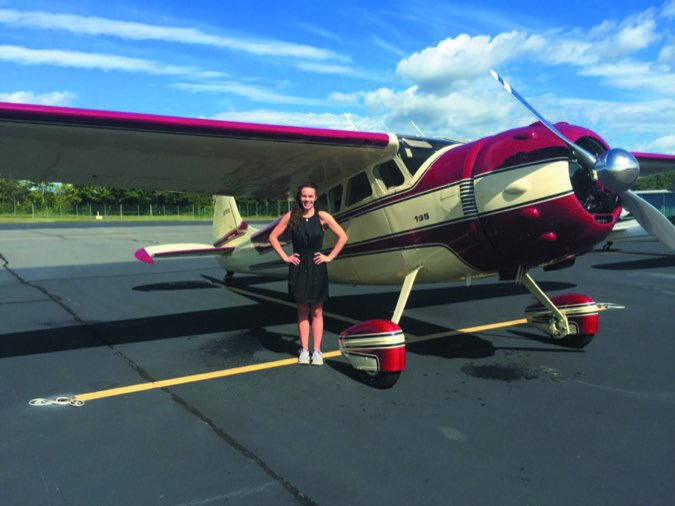
When the day’s flying is complete, it’s time to clean up the airplane before tucking it away. That means wipe off the oil, son. While your flying buddies are already tied down and halfway home, you’ll still be wiping oil from the belly of your 195. Radials are notorious for leaking-some say that they just have Alpha personalities and are merely marking their territory-and coupled with the old-fashioned wet vacuum pump, there’s a fair amount of oil that gets deposited everywhere. It’s a labor of love, though, and merely gives you an opportunity to justify a little extra time at the hangar admiring the airplane’s beautiful lines.
Although the engines were designed for 80-octane avgas, quite a few owners report they have used autogas with success and STCs are available to make this a legal alternative. Those who use 100LL commonly use a fuel additive such as TCP or Marvel Mystery Oil to reduce lead deposit buildups in these low-compression engines.
Value, Insurance
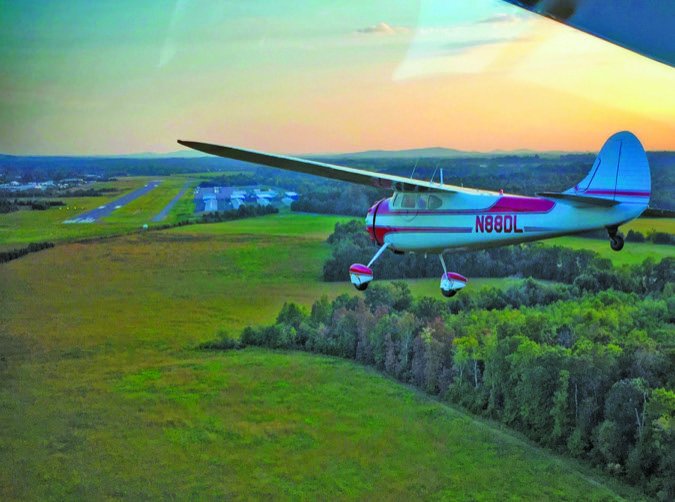
Inflation and a growing image as a classic have brought the resale value of the 195s to multiples of their prices when new. As with other vintage airplanes, the year of manufacture has little bearing on the selling price. By now, many have been restored, so the quality of the machine and equipment extras are the primary determinants of worth.
We perused Trade-A-Plane and www.controller.com and saw asking prices starting at $85,000. Buyers seem to fit in either of two general mindsets: purists who want nothing less than a show-plane restoration just as it shipped from the factory, and those who like the lines and nostalgia, but want a practical flier.
The combination of a tailwheel and an aging airframe has an impact on insurance costs. We learned that there are fewer underwriters who are enthusiastic about writing policies for 195s than, say, for 180s or 182s. Those who are interested had what seemed to us reasonable PIC and time-in-type requirements.
A private pilot with no instrument rating, 200 hours PIC and 25 hours of tailwheel experience and an extensive checkout would likely see premiums of about $2000 to $3000 per year, assuming a $85,000 hull and $1 million liability. That’s about the same as a tailwheel Cessna 180 or roughly one-third more than a 182. Experience and ratings lower insurance premiums, of course.
Maintenance
As one expert put it, “There are three rules for long-term happiness with a 190/195. Gear alignment is crucial, the brakes must be we’ll maintained and the tailwheel strut and steering must be we’ll maintained.”
It’s no secret that there is a serious problem with ignorant maintenance of these airplanes because there was only a rudimentary military maintenance manual published. As a result, not many people know how to properly maintain the airplane. The new owner will invest a little more effort into keeping the plane flying because Businessliners are rare, and fewer mechanics are familiar with the old radial engines and their archaic accessories. Access to the engine accessories is made easier by an engine mount design that allows the powerplant to be swung out from one side, as on a hinge. The first time an onlooker raises his eyebrows at the unusual sight of the engine being canted about 15 degrees to the left, he’s usually mockingly told that “Oh yeah, this 195 has the crosswind engine.”
As for annual inspections, only the price of the inspection itself is comparable to other singles. The number of repairs on the aging airplane usually bumps the price up to a notably higher number.
One common problem with the 195s is a leaking oleo tail strut. Generally, a good overhaul with proper seals will correct this, but some believe servicing it with Granville Strut Seal might be the answer.
Tailwheel strut maintenance is a big deal, perhaps fraught with denial and ignorance. It’s not hard to do, it just has to be done right by someone who knows how. If the chrome inner strut is pitted, it won’t hold pressure; it must be smooth. Never put a spring in the strut-it turns the tailwheel into a pogo stick. Never fly the airplane with the tailwheel strut flat-it will damage the tail.
Insofar as ADs go, there aren’t many, considering the 60-plus-year age of the airplane. Only four require recurrent inspections. There are no ADs on the engine or propeller, something that strikes us as a record of sorts. All the Jacobs and the Continental engines go about 1000 to 1200 hours to TBO.
Parts, Support
Despite the fact that these days Cessna provides little more than moral support, owners report that the parts situation isn’t too bad.
In addition to some parts being available from Cessna (albeit pricey), The 195 Factory (www.the195factory.com) can provide most airframe parts from new manufacture.
Heritage Aero (www.heritageaero.com) has many spares for the straight and crosswind Goodyear wheels and brakes, in addition to instrumentation and providing maintenance. Barron Aviation (www.barronaviation.com) manufactures an approved and improved inboard aileron hinge, which can eliminate a recurring AD check.
You might not be we’ll served by taking your Businessliner to the local Cessna boutique for service-you could find yourself paying for the learning time of the technicians. Recently the International Cessna 195 Club (www.cessna195.org) has
begun hosting owners’ maintenance forums at strategic locations across the U.S. to improve the awareness of the airplane’s special needs. The program offers an opportunity to spend time with “195 professionals” who provide hands-on insight by accompanying the owner and his mechanic in inspecting the few areas that are unique to the type.
Several 195 specialty shops have arisen to cater specifically to the marque. In the northeastern U.S., The 195 Factory provides inspections and repairs. In the Midwest, there is a popular shop recommended by owners-Barron Aviation. Visit them at www.barronaviation.com.
In the West, Sonoma Aero and Heritage Aero have been given accolades. Radial Engines Ltd. (www.radialengines.com) overhauls Jacobs and Continental radials. Air Repair Inc. (www.airrepairinc.com) is the type certificate holder for the Jacobs engines and provides repairs and parts for them and the Continentals, too. Air Repair has modernized the Jacobs engines in many areas, mostly aimed at improving the oil burn and oil leakiness of the engines.
Recently overhauled Jakes are alleged to rival flat engines in their oil use. Some parts for the Continentals are scarce, although rebuilders can make do with used, serviceable parts. The R-755 Jacobs are we’ll supported with many new and modernized parts available. The R-915 330-HP Jake is not an orphan, but not nearly as we’ll supported as its smaller sibling.
Modifications, Clubs
For safety, retrofitting retractable shoulder harnesses (B.A.S. and others) improves survivability in the event of an accident. And the lap belt’s attachment point is relocated from the seat frame to the floor where it can actually do some good.
There’s a popular locking tailwheel (The 195 Factory LLC) which many feel tames the beast’s ground handling.
Hartwig Fuel Systems (formerly Monarch) makes a replacement fuel filler cap that’s designed to repel water and also has individual venting. It’s STC’d for most Cessnas, but not specifically for the 195, so a field approval will be needed.
Although the Lear L2 was the factory-optional autopilot, we note that Brittain has an STC for its B2C system and Genesys for its S-TEC series 30 and 55 systems. (Lots of luck getting repairs on the Lear, by the way.)
Any of these do an adequate job, but we were not able to identify any maker who has certified a yaw damper. This would be a welcome addition due to the aircraft’s considerable adverse yaw characteristics.
Judging from the comments of owners, one of the most useful conversions is from the troublesome Goodyear brakes to Cleveland brakes, which are many times more effective. For increased convenience, the addition of tail push handles (B.A.S. Inc.) helps move the airplane on the ramp.
Avionics upgrades for the 195 can be a challenge. The huge oil tank lives behind the instrument panel, thus requiring radios of short depth, and the engine’s noisy ignition system was designed in 1934 when radios weren’t even on the engineers’ scratch pads. A significant tab can result from the avionics shop’s chasing of the elusive electrical noise source.
Radial Engines Ltd. has been issued an STC for a fuel-injection mod for the Jacobs 275- and 300-HP engines that reduces fuel consumption and evens out fuel mixtures to the cylinders for smoother operation and greater power. The engine originally
had only an oil screen. Many have been retrofitted with oil filters from ADC, Air Wolf or other field STC sources. Airwolf’s site is at www.airwolf.com.
In addition to the Jacobs and Continental engines that Cessna installed on the planes at the factory, the years have witnessed STCs for a few other engines. Perhaps the most common is the Jacobs R-755’s big brother, the L-6. It provides 330 HP for takeoff.
In the 1960s, Page Aircraft Engines adapted a turbocharger, resulting in the R-755S; it’s rated at 350 HP for takeoff/300 HP continuous. Western owners praise the performance improvements for mountain flying. The King Kong of all Cessna 195s resulted from Parks Aviation installing a Pratt & Whitney R-985 with a whopping 450 HP to improve the climb and high-altitude characteristics for aerial photography.
There were only a handful of the latter planes built by Parks-they carry the model designation of “196” after the mod. Most have tip tanks to accommodate the higher fuel flow, but at least one has higher capacity tanks installed in the wings to provide 100 gallons of useable fuel.
The original 10.00 SC smooth-contour tailwheel tire and tube is available, albeit expensive. Some owners have converted to a tailwheel that uses the same tires as a Cessna 180, a much cheaper alternative. They’re available from R-R-R-Russ Aircraft Supply. (See www.russaircraft.com.)
The aforementioned International 195 Club has a broad membership and hosts annual fly-ins at various locations in the U.S. Its website has a hangar talk bulletin board where information is shared and the club publishes a quarterly bulletin for members. It has many technical materials and support information.
Cessna 195 Crunches: Runway LOC
When it comes to care and feeding of the Cessna 195 series, the most common comment we have received from owners over the years is that correct landing gear maintenance is critical to one’s ongoing happiness with the machine. Owners express strong opinions regarding the need to carefully align the landing gear and ensure that the brakes, tailwheel strut and tailwheel steering are correctly maintained-otherwise ground handling may be severely compromised.
Our review of the 100 most recent Cessna 195 accidents utterly confirmed the owner comments. A staggering 70 accidents were connected with landing or takeoff-the highest of any aircraft we’ve ever reviewed. Fifty-four were loss of control (LOC) on landing or takeoff-yes, takeoff, we counted five LOC takeoff accidents, all of them involving either a crosswind or downwind departure attempt.
On top of the 54 common, garden variety LOC accidents were another nine in which a malfunctioning brake was demonstrably involved-lockups or failures.
What also got our attention was the number of gear collapse events, seven, on landing. Most of those turned out to be due to fatigue from pre-existing damage-potentially from a previous groundloop. We saw only two in which the post-accident analysis showed overload as the cause.
Even though the 195 has a long arm from the main gear to the tailwheel, improper brake use, especially when trying to fend off an LOC event, can flip the airplane. Where the accident data reported on the final position of the airplane, 12 of the 70 RLOC accidents ended up with the airplane on its back.
That’s the bad news. Once the landing and takeoff accidents are out of the way-and few of them involved more than minor injuries-the 195 has a surprisingly low rate of accidents that one would associate with an airplane that was designed as a traveling machine. For example, we saw only three fuel-related mishaps. One was fuel exhaustion from a misinstalled cap that was leaking fuel and the pilot refused to believe the fuel gauges even though the passenger repeatedly asked him to land and get fuel.
We have heard reports in the past that because of the geometry of the 195 in three-point attitude that it’s difficult to drain water out of the tanks. The accident reports did not support such a claim. There was one forced landing due to water in the fuel and one in which the post-engine stoppage investigation revealed particles of rust suspended in water in the carburetor-an indicator of ongoing failure to maintain the airplane properly.
There were only three VFR into IMC events and it appears that one involved an incapacitated pilot. Two of those resulted in inflight breakups of the airframe, an indication that the airframe is clean and a diving spiral loss of control event can be fatal.
One pilot managed to raise the tail so high on takeoff that he hit the prop on the runway repeatedly before losing control. There were two ground collisions due to the poor three-point visibility ahead and to the pilot’s right. A third 195 pilot was minding his own business during runup when another tailwheel airplane, a Waco, taxied into his airplane from behind.
Owner Feedback
As an owner of a Cessna 180, I became infatuated with what I think is the finest classic airplane made, the Cessna 195. I was concerned about the radial engine and parts for a 60-year-old aircraft. I found an LC-126 in Texas, had a quick prebuy done by a trusted A&P and bought the aircraft for $98,000. The first yellow flag was that it had not been flown regularly for several years. There were just under 2500 hours on the airframe since it was put in civilian service, and just 25 hours on the engine over the last five years, but a total of 600 hours since overhaul. The interior was an eight out of 10 and the exterior was a seven.
Having read extensively on the International Cessna 195 Club website, I had ignored the admonitions on prebuy inspections and instruction. My son, who had the least experience, groundlooped the aircraft while being checked out by an experienced instructor.
It was time to test the support for these wonderful aircraft with John Barron in Missouri, a guy I talked with before I bought the aircraft. Upon discussion with him, we decided to make some additional repairs and replacement of some skins that had not been properly repaired previously.
Upon stripping the skin from the wing, he found that the outer spar was not connected to the main spar. When the skin came off the fuselage, he found that repair of a prior groundloop was not properly skinned, so that skin had to be changed, too. Then we found a cracked doorpost on the left side, a common problem that might be caught on a prebuy inspection. This rejuvenation project cost roughly $42,000.
I got the aircraft back and blissfully began flying it. I had a propeller overspeed problem and had the prop governor rebuilt, but the problem still existed. We took the hub apart and found that the lubricant had dried out in the kidney bearings. We sent it to Byram Propeller Repair in Fort Worth, Texas, for overhaul. This was $3500, plus installation.
By now, I had replaced four tires while learning to land it and needed to replace the tail wheel tire, which was a Polish tire that was an odd size. A call to Bill Milton at The 195 Factory resulted in the replacement of the tail wheel assembly and a normal size tire. Plus, Milton has the parts that are required for normal maintenance, in addition to many other replacement parts.
As for engine parts and overhauls, Radial Engines and Air Repair provide updated parts. I purchased the Spitfire ignition from Radial Engines. The company is developing new mods for the Jacobs, including fuel injection. It turns out that my fear of parts scarcity was unfounded.
Operating costs at 15 GPH, engine reserves of $21 and $5 per hour for the prop is approximately $116 per hour. An annual runs roughly $3500, while insurance is $2500 per year-down from $3500 when I first purchased the aircraft.
A few years ago I had a prop strike on a grass strip in Michigan at the 195 club convention. I called Phil Pedron who acquired new blades, did a field replacement at the strip and flew the aircraft back to Texas. My worry of the radial engine dissipated.
We pulled the engine and sent it to Air Repair for teardown. I purchased a remanufactured engine with steel valve seats, valve rotators and modern gaskets. Now the airplane apparently no longer feels it necessary to mark its territory with oil. The price was $30,000, plus prop blades and installation.
I’ve had two really good (but expensive) annuals by a knowledgeable mechanic who rigged the aircraft. So now I have a wonderful rejuvenated LC126/195. I also replaced the old radio with a Garmin GTN650 GPS, making it an IFR-capable classic cross-country aircraft.
Leading the Cessna 195 community are the members of the International Cessna 195 Club. Started in 1967 by Dwight Ewing and being carried on by Coyle Schwab, Larry Nelson and Aubie Pearman, these presidents and their boards of directors hold maintenance clinics, annual conventions and caravans. They carry on the tradition of fellowship, education and support of a great community. Its website epitomizes social networking.
The four years I have owned the LC-126 have been fun, instructive and adventurous, if not inexpensive. I look forward to many more hours of pleasurable flying in it.
Robert Donnelly
via email

